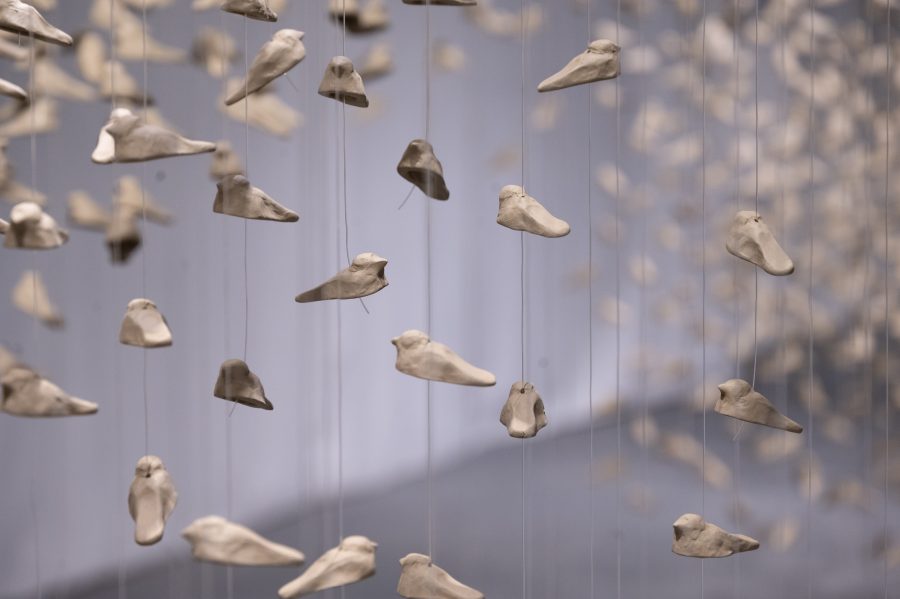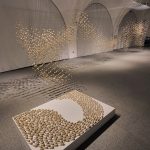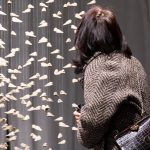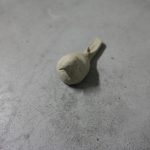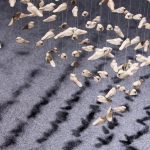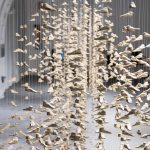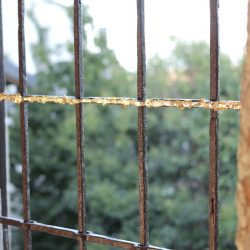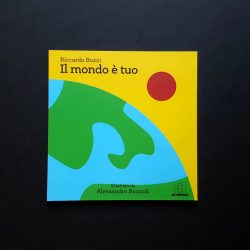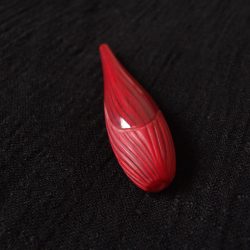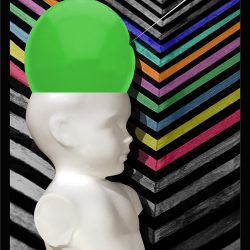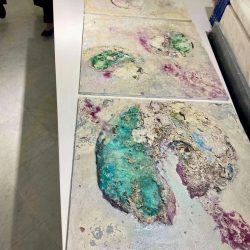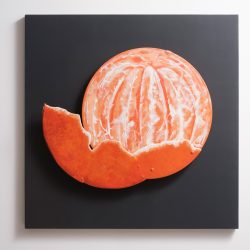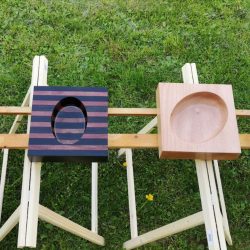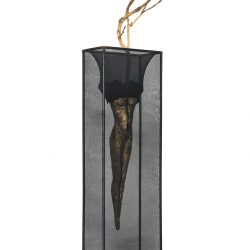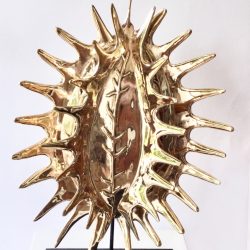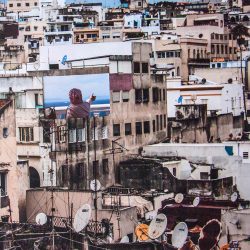work
Il volo ( al Centro Trevi/ Bolzano, 2023 )
| category | Installation |
| subject | Travels, Political / Social, Nature, Beauty, Animal |
| tags | contemporary art, volo, still life, community, uccellini, nature |
| base | 180 cm |
| height | 250 cm |
| depth | 80 cm |
| year | 2022 |
From the Still Life series, this installation starts with a small bird made of clay. The structure from which these birds hang has a precise measurement of 80x180, and it is installed at least 2,5 m from the ground.. The installation starts with hundreds of birds on the ground which are then hung on threads to look like they take off in flight and then the dance of the flocks in the skies. In the specific case of this installation in Bolzano, about 4000 birds were hung and about 300 were put on a low platform 100x150cm. This installation has been created and developed to enable its performance at different possibilities of location. For the exhibition in Bolzano, an introduction text was written by the curator Nicolò Faccenda:
The Still Life cycle, created by Sun Hee Moon between 2020 and 2022, includes
fifteen oil canvases and a large installation consisting of a few thousand
little birds (starlings). Born from a first model modeled in clay, the project was
gradually expanded to the present state. Once the subject was settled, it has become
protagonist of some initial canvases, in which he is represented in an interior (the work space
by the artist), in dialogue with elements of everyday life.
It summarizes a stratified series of meanings linked to the circumstances in which it was born - the first lockdown -, up to a broader reflection on the relationship between human beings and their environment, as well as on the model of collective relationship between individuals. With this series, in fact, the artist intends to open a double perspective, centered on the lessons that can be drawn from the natural world, for a hypothesis of resistance and care. If on a general level the intention is to recall the naturalness of the cycles of life, death and rebirth, at the same time it refers to the adaptability manifested by nature precisely in that period of forced retreat of human beings, instilling the hope of the possible restoration of a minimum condition of balance and sustainability in the relationship with the ecosystem.
Through free cooperation, the flock arrives at a unity capable of
ensure overall efficiency, but at the same time functional to the survival of
each component. There is no leadership or a previously defined model in it
to adapt to: simply, you fly in the same direction, being careful not to collide
your neighbor. The interest is individual and community, the common good and that of
individual are in a relationship of perfect reciprocity, local input becomes behavior
general. Far from an ideological perspective, the artist claims through metaphor
of the flock the validity of what she defines as “collective behavior
self-organized", where "the individual is important, but the group is essential", where "the
common work for a collective good” leads to those benefits deriving from a
spontaneous sharing, harmonized with the needs of all the components of the
group. It is not a question of a juxtaposition of divided and competing parts, but rather
of the surplus that derives from what, with Aristotle, can be defined as a "whole greater than the sum of its parts".
In this utopian remodeling of relationships between individuals, the artist recovers from his own
culture of origin a principle of resonance and harmonization between the human being and the
nature. Three key concepts of Korean thought, in fact, can further clarify the
different facets of the meaning of the work. First of all that of Han, who “celebrates the
determination, reverence for effort and perseverance along with a feeling of
melancholy”, from which so much the resistance perspective with respect to general adversity derives
in which the work is born, as well as its design value. If Heung consists of
“that incredible feeling of joy you get when family gets together, when you
it is in nature, when you are enjoying a cup of pine needle tea or reading a good book,” it is
possible to grasp that idea of harmonization of the individual with himself, with others and
with nature itself, which presides over the hypothetical convergence between the model of
animal and human behavior. Finally, with Jeong, “the art of giving without expecting
nothing in return, to give priority to the well-being [...] of the community [...], as well as one's own ", yes
reaches the central meaning, in the principle of a sincere loyalty of the individual towards
of the collective, aimed at pursuing the individual good through realization
of the general interest. [2]
Nicolò Faccenda
[2] Barbara J. Zitwer, Korean Thought. Traditions and history of the roaring Asian tiger, Giunti, Florence 2022, pp. 19-20.
The Still Life cycle, created by Sun Hee Moon between 2020 and 2022, includes
fifteen oil canvases and a large installation consisting of a few thousand
little birds (starlings). Born from a first model modeled in clay, the project was
gradually expanded to the present state. Once the subject was settled, it has become
protagonist of some initial canvases, in which he is represented in an interior (the work space
by the artist), in dialogue with elements of everyday life.
It summarizes a stratified series of meanings linked to the circumstances in which it was born - the first lockdown -, up to a broader reflection on the relationship between human beings and their environment, as well as on the model of collective relationship between individuals. With this series, in fact, the artist intends to open a double perspective, centered on the lessons that can be drawn from the natural world, for a hypothesis of resistance and care. If on a general level the intention is to recall the naturalness of the cycles of life, death and rebirth, at the same time it refers to the adaptability manifested by nature precisely in that period of forced retreat of human beings, instilling the hope of the possible restoration of a minimum condition of balance and sustainability in the relationship with the ecosystem.
Through free cooperation, the flock arrives at a unity capable of
ensure overall efficiency, but at the same time functional to the survival of
each component. There is no leadership or a previously defined model in it
to adapt to: simply, you fly in the same direction, being careful not to collide
your neighbor. The interest is individual and community, the common good and that of
individual are in a relationship of perfect reciprocity, local input becomes behavior
general. Far from an ideological perspective, the artist claims through metaphor
of the flock the validity of what she defines as “collective behavior
self-organized", where "the individual is important, but the group is essential", where "the
common work for a collective good” leads to those benefits deriving from a
spontaneous sharing, harmonized with the needs of all the components of the
group. It is not a question of a juxtaposition of divided and competing parts, but rather
of the surplus that derives from what, with Aristotle, can be defined as a "whole greater than the sum of its parts".
In this utopian remodeling of relationships between individuals, the artist recovers from his own
culture of origin a principle of resonance and harmonization between the human being and the
nature. Three key concepts of Korean thought, in fact, can further clarify the
different facets of the meaning of the work. First of all that of Han, who “celebrates the
determination, reverence for effort and perseverance along with a feeling of
melancholy”, from which so much the resistance perspective with respect to general adversity derives
in which the work is born, as well as its design value. If Heung consists of
“that incredible feeling of joy you get when family gets together, when you
it is in nature, when you are enjoying a cup of pine needle tea or reading a good book,” it is
possible to grasp that idea of harmonization of the individual with himself, with others and
with nature itself, which presides over the hypothetical convergence between the model of
animal and human behavior. Finally, with Jeong, “the art of giving without expecting
nothing in return, to give priority to the well-being [...] of the community [...], as well as one's own ", yes
reaches the central meaning, in the principle of a sincere loyalty of the individual towards
of the collective, aimed at pursuing the individual good through realization
of the general interest. [2]
Nicolò Faccenda
[2] Barbara J. Zitwer, Korean Thought. Traditions and history of the roaring Asian tiger, Giunti, Florence 2022, pp. 19-20.



